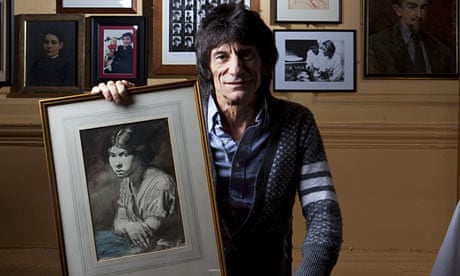Music and the visual arts have had a loose relationship for decades. From the 60s onward, bands like the Beatles, The Who and Roxy Music all had at least one member who went to art school before embarking on a music career. Others, like Tony Bennett and Ronnie Wood, pursued careers as painters in the later part of their careers.
Still, the funding and business side of the visual arts has traditionally been dominated by trust funds, the rich and corporate City patrons. There is evidence that this is starting to change. As the music business became more lucrative, so artists such as Madonna, Sir Elton John, Jarvis Cocker, Brian Eno and his ex-band mate Bryan Ferry invest much of their accumulated wealth in both modern and classical art. Even Kylie, Robbie and the Gallagher brothers have been seen in art galleries and auction houses.
Music manager and promoter Raye Cosbert thinks that the art community can gain more than just funding from the music industry – he thinks it could use the expertise and experience gained from manoeuvring some of the most successful music careers of the last couple of decades. That's why this week he along with artist agent Serena Morton launched new art venture Morton Metropolis.
If anyone should know how to nurture the talented, but emotionally fragile, personalities that frequently populate the art world, it's Cosbert. He has managed Amy Winehouse since the spring of 2006, and has also worked as a promoter with acts such as Blur, Robbie Williams, Lily Allen, Massive Attack and Björk.
"Developing talent, that's what I do," he says. "I find it and I A&R it, which I guess could be called curation." Cosbert thinks that although accessibility to music has changed the music business, what hasn't changed is that talent still needs to be found and nurtured. "The middle man is still important. What Serena does is to transpose my experience into the art world."
Morton had taken Cosbert, a personal friend, to artist Gerald Laing's studio to see his piece Belshazzar's Feast, based on a picture featuring Raye at a table with Amy Winehouse reaching for a bottle of champagne at the Ivor Novello awards. From then on, Cosbert's interest in the art world grew.
The idea for the project came about after a chance encounter with another music manager – Pat Magnarella, who looks after Green Day. "Pat was the first music industry person to truly spot the market," explains Morton. Last year, Magnarella's management signed up UK visual artist Charming Baker – giving him some rock'n'roll-style promotion – and recruited Morton to work on a US art show for them.
"I introduced Raye to Pat," she continues. "and seeing what Pat was doing in the US got Raye thinking along the same lines."
"The art world is ready for some new blood," says Morton, who joined Christie's 20th century and contemporary British arts department in the 90s and set up one of the first pop-up shows in London's Brick Lane in 1998. "We want to make it more fun."
Morton Metropolis is funded by Cosbert and, he says, Morton provides "15 years of eye". The gallery opens with an exhibition of prints by Gerald Laing, including Belshazzar's Feast, and is aptly located on Berners Street, where the Perfoming Right Society and UK Music are also situated. The company will focus on artists in their mid-careers, aiming to spot talent that has been overlooked by the more established houses. "We want to provide a safety net for our artists," says Cosbert.
Winehouse's manager thinks he can take the business of art forward. One thing artist managers and concert promoters know about is risk management – they understand the intricacies of profit and loss. In the same way that a record label can use the profit from one successful artist to underpin the funding for another whose music isn't selling well enough, so Cosbert and Morton say that if they're able to help two artists to become the new Hockney, they can afford to support other up-and-coming artists with the profit.
"Art is long, life is short," says Cosbert. "I was tired of going to my friends' houses, seeing Ikea pictures on the walls. I haven't felt this excited for a long time."
But maybe there's more to it than that. As the internet has made music more disposable, easily transferable and downloaded for free, the visual art world may in the future become even more alluring to people in the music business. After all, you can't download a painting, installation or sculpture.

Comments (…)
Sign in or create your Guardian account to join the discussion